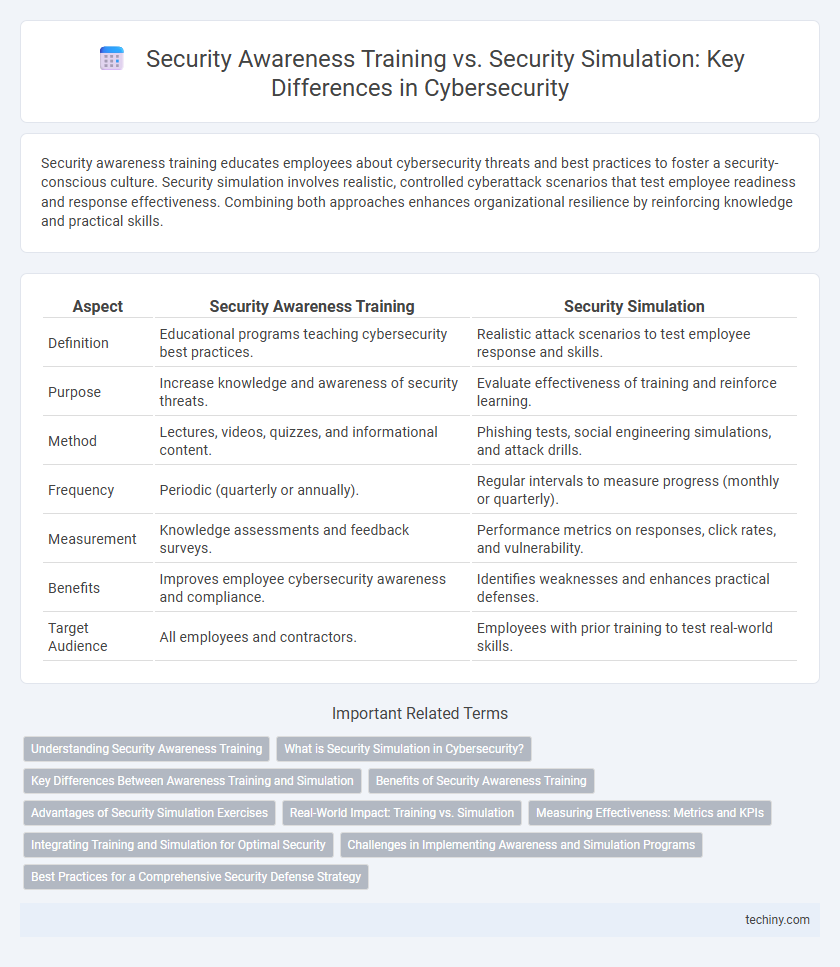Security awareness training educates employees about cybersecurity threats and best practices to foster a security-conscious culture. Security simulation involves realistic, controlled cyberattack scenarios that test employee readiness and response effectiveness. Combining both approaches enhances organizational resilience by reinforcing knowledge and practical skills.
Table of Comparison
| Aspect | Security Awareness Training | Security Simulation |
|---|---|---|
| Definition | Educational programs teaching cybersecurity best practices. | Realistic attack scenarios to test employee response and skills. |
| Purpose | Increase knowledge and awareness of security threats. | Evaluate effectiveness of training and reinforce learning. |
| Method | Lectures, videos, quizzes, and informational content. | Phishing tests, social engineering simulations, and attack drills. |
| Frequency | Periodic (quarterly or annually). | Regular intervals to measure progress (monthly or quarterly). |
| Measurement | Knowledge assessments and feedback surveys. | Performance metrics on responses, click rates, and vulnerability. |
| Benefits | Improves employee cybersecurity awareness and compliance. | Identifies weaknesses and enhances practical defenses. |
| Target Audience | All employees and contractors. | Employees with prior training to test real-world skills. |
Understanding Security Awareness Training
Security Awareness Training focuses on educating employees about cybersecurity best practices, threat identification, and safe online behavior to reduce human-related risks. It covers topics such as phishing detection, password management, and recognizing social engineering attacks, enhancing overall organizational security posture. Regular, updated training fosters a security-conscious culture that strengthens defense against cyber threats.
What is Security Simulation in Cybersecurity?
Security simulation in cybersecurity involves creating realistic attack scenarios to evaluate and enhance an organization's response capabilities against cyber threats. By mimicking phishing attempts, malware intrusions, or social engineering attacks, simulations provide hands-on experience and identify vulnerabilities in employee behavior and system defenses. This proactive approach helps organizations improve incident response strategies and reduce the risk of successful cyberattacks.
Key Differences Between Awareness Training and Simulation
Security awareness training educates employees on cybersecurity principles, common threats, and best practices through structured lessons and interactive content. Security simulations test employee responses to realistic cyberattack scenarios, such as phishing emails or ransomware, to evaluate readiness and reinforce learned behaviors. Awareness training focuses on knowledge acquisition, while simulations emphasize practical application and behavior assessment under simulated attack conditions.
Benefits of Security Awareness Training
Security Awareness Training enhances employees' ability to recognize and respond to cyber threats by providing comprehensive education on phishing, social engineering, and best security practices. This proactive approach reduces the risk of breaches by fostering a security-conscious culture and improving overall compliance with industry regulations such as GDPR and HIPAA. Continuous training updates ensure that staff stay informed about evolving cyberattack tactics, strengthening the organization's cybersecurity posture.
Advantages of Security Simulation Exercises
Security simulation exercises provide realistic, hands-on experience that enhances employee response to cyber threats by replicating actual attack scenarios such as phishing or ransomware attempts. These simulations identify vulnerabilities in real time, allowing organizations to address weaknesses before a genuine breach occurs. Continuous engagement through simulated attacks improves retention of security protocols and fosters a proactive security culture.
Real-World Impact: Training vs. Simulation
Security Awareness Training equips employees with fundamental knowledge and best practices to identify and avoid cyber threats, reducing human error vulnerabilities. Security Simulations provide immersive, hands-on experiences by replicating real-world cyber attack scenarios, enabling users to apply skills in a controlled environment and improve response times. Combining both approaches enhances organizational resilience by reinforcing theoretical knowledge with practical experience, leading to measurable decreases in security incidents and data breaches.
Measuring Effectiveness: Metrics and KPIs
Measuring effectiveness in Security Awareness Training involves tracking metrics such as completion rates, quiz scores, and phishing click-through rates to assess employee understanding and behavior change. Security Simulation focuses on KPIs like the number of simulated attack responses, detection times, and user remediation actions, providing real-world performance insights. Combining both approaches enhances risk reduction by quantifying knowledge retention and practical reaction capabilities.
Integrating Training and Simulation for Optimal Security
Integrating security awareness training with security simulations enhances organizational cybersecurity by combining theoretical knowledge with practical experience. Security awareness training educates employees on identifying threats and best practices, while simulations provide real-time, interactive environments to test and reinforce these skills. This blended approach ensures users are not only informed but also prepared to respond effectively to evolving cyber threats, reducing the risk of successful attacks.
Challenges in Implementing Awareness and Simulation Programs
Implementing Security Awareness Training faces challenges such as engaging employees consistently and measuring behavioral change effectively. Security Simulation programs often struggle with replicating real-world attack scenarios and ensuring participant seriousness during simulated exercises. Both approaches require continuous updates to address evolving cyber threats and maintain organizational relevance.
Best Practices for a Comprehensive Security Defense Strategy
Security Awareness Training educates employees on recognizing threats and adopting safe behaviors, while Security Simulations provide hands-on experiences through realistic attack scenarios to reinforce learning. Combining frequent, role-specific training sessions with simulated phishing and ransomware exercises enhances threat identification and response efficacy. Integrating both methods into a continuous cybersecurity program fosters a proactive organizational culture and significantly reduces susceptibility to breaches.
Security Awareness Training vs Security Simulation Infographic

 techiny.com
techiny.com